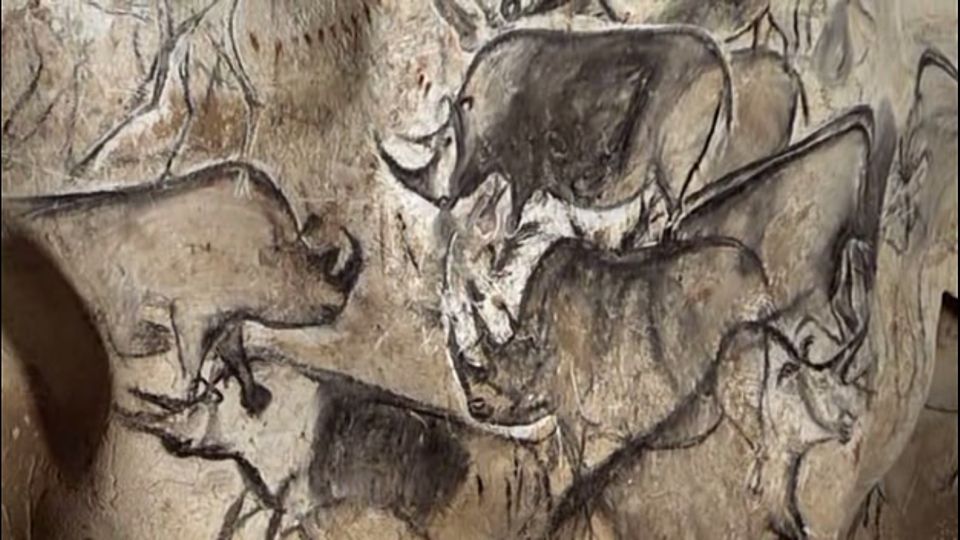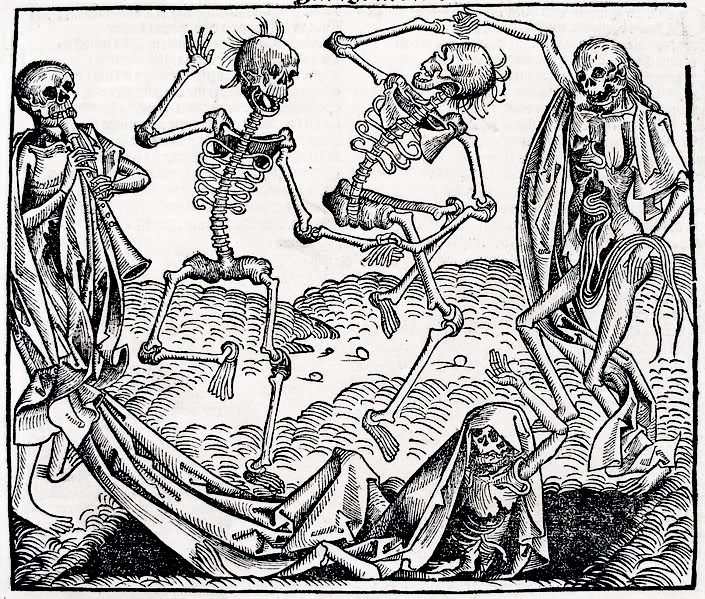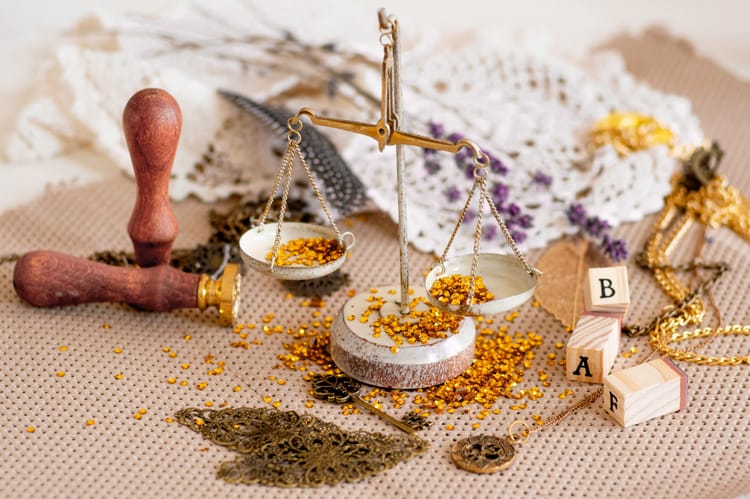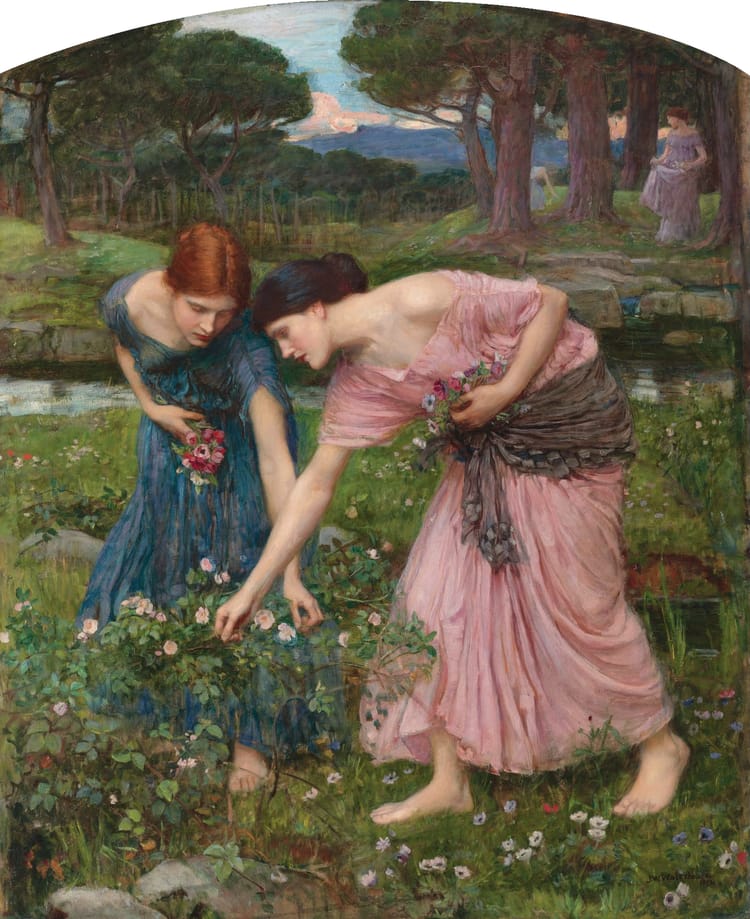Full Moon (Again): Art as devotional act

Hello, and happy full moon time — once more. The timing of the moon's changing over the past week seemed such that I should do two full moon posts. Of course now the last quarter is coming very soon.
Until then, I have another principle to establish in time given to the fertile and creative: considerations for art, especially for its role in living ritualistically, and in breaking the various chains of the world.
Art is the spiral
Often when people speak of art's revolutionary potential they mean because art tells us great truths. As I wrote last week regarding tarot, such great truths come in the form of great lies, because sometimes that's the only way our minds can make sense of the truth itself; and I referenced art in the same post since with art the same phenomenon can be found.
But however important art's function may be as a revealing force, there are many cases where even when a work of art tells us truths, it also embodies its own truth. Not all art is made with a conscious purpose. The point is simply that someone had an idea for some art, and then they made that art. David Lynch is a prime example insofar as he routinely eschews explaining his own work and insists that he made something just because he "got an idea," but I think this habit applies with equal frequency to artists in all media, whose work may be less abstract than Lynch's, or conversely even more abstract. Whatever the case, of course this never stops the artist's audience from interpreting their own impressions of any truth(s) that they believe the artwork seems to offer, and this is a fascinating topic unto itself. Nevertheless, while I prefer to make and encounter art that doesn't, for example, leave room for outright reactionary political implications, etc. — as I've grown older I've developed a larger and larger appetite for art that doesn't bother trying to justify itself, whether by staying abstract altogether or by offering a very straightforward representation that, though capable of irony, assumes that its target audience is not "everyone," and therefore doesn't bother trying to recruit "everyone."
This isn't a progressive vs. reactionary quality, left vs. right, even though my political allegiances within art are rather firm. It's rather about art owning its ecstatic side, being ecstatic. Call it raw aesthetic, call it the demolishing of self-consciousness, all it art for art's sake. Call it singing to the stars because you're under the stars and you happen to want to sing.
But if art itself can be ecstatic, the fact remains that the process of creating it is a fertile one, for it is indeed creation, exerting oneself to make something outside of oneself. As the fertile chases the ecstatic and the ecstatic chases the fertile, this makes art a spiral, its logic recursive.
The spiral mirrors how all art is derivative, replicative.
And this is like life, Life, all its kingdoms evolving together in a spiral of eternal changes.
And so art seems like an impossibly appropriate outlet for any tool-using life form develop. Just as individual artworks represent individual experiences, art (as a concept) represents life (as a concept).
As above, so below.
Choosing to make art means choosing to engage with this sacred spiral. I'll mostly focus my writings on art during the fertile full moon, because ultimately I contrast art in my head with the new moon's mysteries, i.e. the void of what cannot be given form at all. But I offer these thoughts now as a reminder to myself more than as a lesson to anyone else: that beneath art's fertile exterior, there is an ecstatic core, and within that core is another fertile layer, and an ecstatic layer, and so on, all nested onionlike. Choosing to make art means to give my devotion to the universe.
Making art as a ritual offering
Because I find that art's most powerful function is simply in being made at all, this is the first way that I fit art into my ritual practices. The art may depict something directly sacred or it may not. The goal is to make it.
The end result will be something precious, not only due to its uniqueness or any particular beauty, but more profoundly due to the sheer intention of making it. I take a risk in both the process of creation — taxing my body and mind as one — but likewise in letting anyone else witness the final art, whether that mean showing the thing to a known audience or simply releasing the thing into a place where an audience might be found. The precious working may there be destroyed, stolen, misunderstood, or rejected.
Yet I offer it in vulnerability, for it's more important that I take the risk of letting the art exist than of taking the risk of letting it not exist. And in that moment of decision, I dedicate my art to the very cosmos and to every animist spirit and to every conception of godhood within such a framework.
And to my keeper, the devil. The deal I made with him was not for the sake of improving my art. But my art still belongs to him as much as it belongs to me.
Making art as a meditation
The creative process, the birthing of art, quells my anxious mind in the same way that pregnancy is known to reduce the symptoms of some autoimmune inflammatory conditions (such as multiple sclerosis) as the immune system is suppressed. Obviously that doesn't mean the solution for all autoimmune illnesses is to be pregnant all the time — especially not if you can't or would rather never — and likewise as much as I'd love to be making art absolutely all the time, I need to take care of myself in other ways that art interferes with. I immerse myself very quickly in art; I enter a flow state as a matter of course; for me this isn't a gift so much as a neurodivergent inevitability, and so if I commit myself to art for a couple of hours there's a chance this will become all the hours or the whole day. I'm not good at remembering to eat or drink under such circumstances, or at letting myself sleep. I'm restrained regularly from making bad health choices for art's sake because I'm married to and live with someone whose pause buttons are wired a little differently than my own. I'm 35 years old and I'm still only now figuring out techniques for comfortably allowing my art to be interrupted with good reason.
This must come down to moderation, because although appeasing my need for art at the expense of other things could make art seem like an unhealthy habit, art is one of the ultimate soothers of my eruptive brain. The only things that can match it are actual therapy (which occurs on a necessarily limited basis) and sex/kink/any other wildly stimulating somatic explosion (which relies on the readiness of a participant). Sometimes, like in therapy's case, I need to just let the cymbal-smashing monkey in my head run amock in front of someone who can then help me assess whether the monkey's cymbals are at least smashing in a steady rhythm or focused on anything genuinely important. But otherwise I persistently benefit from putting my racing whirlwind of thoughts toward creative acts, rather than languishing in an unstimulated state and letting my brain make up frightened fictions about reality to no good end.
I admit readily that I'm someone who's afraid to try most psych medication because I worry it would repress creative abilities without doing enough to curb the parts of my brain that my creativity can shut up. I take alprazolam as needed[1] and I cheer for other people who find meds that work for them, but generally prodding my brain chemistry is outside my risk profile, unless it were to happen indirectly, such as via hormones[2]. More than medication, it's best for me to go with routes like meditation — and art is one of those routes.
Making art as a monastic calling
Despite how it's physically (and to some extent emotionally) unhealthy for me to pursue art too intensively for too long, as a witch I know that I'm living most authentically, and most in tune with the powers I serve, if I can pare down as many non-ritual aspects of my life as possible, leaving myself with mostly ritual. I call this following rite, and each Calan Gaeaf/Samhain I vow to rid myself of things which are not rite. Life is too short for me to not follow rite as much as humanly possible.
In following rite, I'm learning how taking care of my body is one such noble and vital task, but I've also developed a sharpened sense for truly unnecessary things that distract me from rite, especially from the art portion. Why try to "keep up" on consuming a glut of movies, TV, and books just because a lot of people are talking about it? Honestly I do consume a lot of these things still (especially movies), but I'm proud of my deliberate taste and I don't worry about belonging to some conversational zeitgeist. And why spend any more time on social media than is necessary to keep up with people I really care about? Every minute wasted doomscrolling or catching up on fights that don't involve me is a minute I could have been focused on art or other rite. I'm still working on this one, but it feels like I make big steps every year, and the process links directly to realizing various things about how the internet can sometimes still be good but is often bad — how if the world is going to be saved from oblivion, that transformation is going to involve people being online less, not more, or at least being online in very different ways than how "being online" currently looks.
I feel like when I make choices to purge myself of what isn't rite, it's fairly monastic of me, which is funny since I'm both a more-or-less-ex-Catholic and a satanist. But as I'll keep illustrating throughout newsletter editions, my (spi)ritual life is full of bizarre ironies like this. I'm not trying to rid myself of "worldly" things, I'm not aiming for some ideal of ascetism, and yet my psychological salvation is through living simply, in the sense of living in a precisely focused way. Let me make art, make love, take care of my body, take care of a family and home, answer my other concrete ritual callings, connect with the earth and seasons, indulge in non-exploitative pleasures, perform a little work to meet certain basic needs, extend myself when possible to help people I know of who need help, and build local community for its own sake and for protection against hard times. This is a lot of things, but for each of these there are a dozen other interferences fomented by our society and the lifestyle it engenders.
Some of the calmest fragments of time in my life, spread out over years, were the 1-2 hours per week that I used to spend writing and illustrating the core grimoire for my owner and I. The grimoire's illustration style is utterly my own but the writing is calligraphy, somewhere between blackletter and uncial script, and so each time that I worked on it, I felt like a medieval monk committed to transcribing the very word of god, even though the words I wrote were very much not Christian.
Looking ahead to other art talk
I'm going to write more in future posts about my process for and discoveries made through specific art projects, albeit with the limitation of not disclosing too much about projects that would dox myself or (as in the grimoire's case) projects that are literally occult, secretive. Even with that rule in place, there's still a lot I can talk about, especially since I've tried my hand at quite a few art forms. Writing is my strongest and most instinctive one, but I'd like to keep getting better at drawing and painting (always very idly indulged hobbies), to incorporate fiber arts too, and to come back to my neglected practices of music, filmmaking, and theatre. Theatre, theatre! There lie so many mysteries indeed. I'm sure kink will also find its way in there, not only as theatre's close cousin but as it often doesn't seem like enough for many people (including myself) to do kink purely as a private, dynamic energy flow, and rather to make art out of kink — whether through photographing the literal activities, performing those activities with an aesthetic flair, or bringing those activities to fictitious narratives.
All artistic things have the power to simultaneously heal trauma, quiet anxiety, bring isolated souls into one shared space, and worship the world. I can't wait to stitch all of this together in the months and seasons to come, and to hear your thoughts if you have any.
[1] Very, very sparingly. It's a starter dose and I've sworn only to take it when I feel physical panic setting in or when I know I'm about to go through at least 60 minutes of something where it's imperative that I relax (but where it's unlikely that I'd be able to relax on my own). I get prescribed five pills at a time and I think it takes between six to twelve months for me to go through all of them, so far.
[2] I definitely experienced mental health differences both starting and discontinuing testosterone therapy. To this day I don't know which situation was better or worse. What I do know now is that my moods are very much hormonally affected, and my obgyn has speculated repeatedly that I might benefit from receiving estrogen or progesterone therapy as a person with ovaries because I might have a natural hormone imbalance and/or I might have endometriosis. I haven't tried this type of hormone therapy yet because the non-psychiatric side effects are themselves a risk I'm still weighing; but if I ever do wind up going ahead with it, and I get a little less crazy as a result, I'll welcome that. (And sometime I should write about my increasing choice to claim/accept "crazy" as a neutral evaluation of myself.)
A substantially shorter post this week. Incredible. Thank you for reading, of course! Next week I plan to transition smoothly into a larger discussion of anxiety within our present global/cosmic timeline. As usual, it would really help me continue writing this newsletter if you could upgrade your subscription to a paid one, but as long as you can stay subscribed in any sense, the moral support also helps because whatever I have to say, I know people are reading on the other end. Thank you again, kith and kindred.





Member discussion